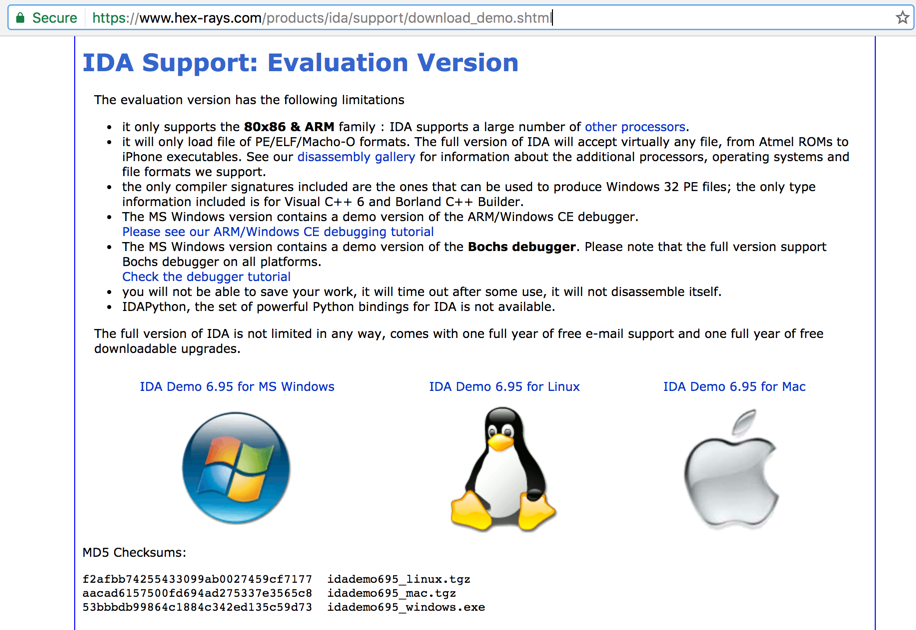
- #INSTALLING IDA PRO LINUX INSTALL#
- #INSTALLING IDA PRO LINUX PRO#
- #INSTALLING IDA PRO LINUX LICENSE#
- #INSTALLING IDA PRO LINUX DOWNLOAD#
The paid version(s) (of IDA) do support Linux and Mac in addition to Winblowz. There are some other interactive dissamblers such as the reasonablly popular and well accepted Lida, which is for Linux. From my limited experince, the free version has always worked just fine for me with WINE, though a VM is certainly a better option (given you have the choice!). For me however, everse engineering is just a side hobby in which I occasionally dabble so it's not really an area of my expertise.
#INSTALLING IDA PRO LINUX PRO#
IDA Pro is generally the de-facto standard for any malware analysts I've spoken with.
#INSTALLING IDA PRO LINUX LICENSE#
$ /home/agustin/opt/ida/idaq64 And that's it, now you have a running version of IDA Pro all with IDAPython running as it should.The problem with your suggestion is the annoying fact that you still need a valid license in order to run Windows in a virtual machine (not that this ever stopped anyone, but I'm just stating the facts), at which point you might as well just get the real/whole thing (Windows, that is).

$ export LD_LIBRARY_PATH="/opt/pym32/lib" There are multiple options but for simplicity sake I choose to export the environment variable `LD_LIBRARY_PATH` and make it point to `/opt/pym32/lib` The last step is to tell the loader where those libraries are.
#INSTALLING IDA PRO LINUX INSTALL#
$ sudo make install This will install python in the directory `/opt/pym32` along with all the needed shared libraries for IDAPython to run. configure -prefix=/opt/pym32 -enable-shared The steps you need to follow are described bellow and need to be issued in the Python2.6 source directory: So I took another way and tried to build it from the source. This was not ideal since I always ended up breaking some dependencies and the package manager was not happy about it.
#INSTALLING IDA PRO LINUX DOWNLOAD#
In a previous iteration of this blog entry what I did was to download these packages from an old Ubuntu repository. We need a dynamic library that comes from Python 2.6 and as the release notes says, Python 2.6 has been deprecated. We need to proceed in the same way as we did before, but there is a slight difference.

Once we have installed each one of the libraries IDA Pro will fire up, but we will receive a dissapointing message the the IDAPython plugin is not working due to missing dependencies.ĭlopen(/home/agustin/opt/idapro/plugins/x): libpython2.6.so.1.0: cannot open shared object file: No such file or directory /home/agustin/opt/idapro/plugins/x: can't load file Libxext6: /usr/lib/x86_64-linux-gnu/libXext.so.6Īs we can see, the file is provided by `libxext6`, but we need to take into account that we need the IA32 versions of the libraries.įortunately, Ubuntu does allow us to install both versions and it is just a matter of adding ":i386" at the end of the package name. So for each of the missing libraries we proceed like this:

Once we have the list of missing libraries, we need to see from which packaged they come from. To do so we can use the `ldd` command to print all the dynamic libraries missing: While effective, this is in my opinion not ideal.įortunately, in the latest version of Ubuntu it is possible to install almost all the IA32 dependencies by hand following a simple scheme.įirst we need to see which dynamic libraries are not found by the loader. In previous versions of Ubuntu what I had to do to achieve such task, is to build a IA32 chroot environment (following this guide). Installing IDA Pro on Linux (AMD64) can be a pain.


 0 kommentar(er)
0 kommentar(er)
